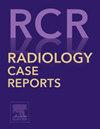Rasmussen aneurysm presenting with massive hemoptysis in a tuberculosis survivor: Diagnosis with CT pulmonary angiography
Q4 Medicine
引用次数: 0
Abstract
Pulmonary artery pseudoaneurysm (PAP) is a rare but potentially fatal cause of hemoptysis, most commonly associated with tuberculosis or chronic cavitary lung disease. Prompt recognition through imaging is critical to enable timely intervention and improve survival. We report the case of a 57-year-old male with a history of poorly controlled type 2 diabetes mellitus and hypertension who presented with massive hemoptysis. Computed tomography pulmonary angiography (CTPA) revealed a pseudoaneurysm arising from a segmental branch of the left lower pulmonary artery, located within a residual post-tuberculous cavity containing heterogeneous hyperdense fluid suggestive of recent hemorrhage. Digital subtraction angiography (DSA) confirmed the diagnosis, although images were not archived, and the patient underwent successful endovascular embolization. However, he later developed septic shock, hyperosmolar hyperglycemic state, and ultimately suffered cardiac arrest despite supportive care. This case highlights the importance of early diagnosis of PAP using CTPA in patients presenting with hemoptysis, especially those with a history of pulmonary tuberculosis. Despite appropriate endovascular treatment, systemic complications may lead to poor outcomes. Early recognition, aggressive management, and interdisciplinary care are critical to improve prognosis, particularly in patients with comorbidities.
肺结核幸存者的拉斯穆森动脉瘤表现为大咯血:CT肺血管造影诊断
肺动脉假性动脉瘤(PAP)是一种罕见但潜在致命的咯血原因,最常与肺结核或慢性空洞性肺疾病有关。通过影像及时识别是及时干预和提高生存率的关键。我们报告一个57岁的男性,有控制不佳的2型糖尿病和高血压病史,表现为大量咯血。ct肺血管造影(CTPA)显示一假性动脉瘤,起源于左下肺动脉的节段性分支,位于残留的结核后腔内,内含异质性高密度液体,提示近期出血。数字减影血管造影(DSA)证实了诊断,尽管图像没有存档,并且患者成功进行了血管内栓塞。然而,他后来出现感染性休克、高渗性高血糖状态,尽管有支持治疗,但最终心脏骤停。本病例强调了在咯血患者,特别是有肺结核病史的患者中,使用CTPA进行PAP早期诊断的重要性。尽管适当的血管内治疗,系统性并发症可能导致不良的结果。早期识别,积极的管理和跨学科的护理是改善预后的关键,特别是对于有合并症的患者。
本文章由计算机程序翻译,如有差异,请以英文原文为准。
求助全文
约1分钟内获得全文
求助全文
来源期刊

Radiology Case Reports
Medicine-Radiology, Nuclear Medicine and Imaging
CiteScore
1.10
自引率
0.00%
发文量
1074
审稿时长
30 days
期刊介绍:
The content of this journal is exclusively case reports that feature diagnostic imaging. Categories in which case reports can be placed include the musculoskeletal system, spine, central nervous system, head and neck, cardiovascular, chest, gastrointestinal, genitourinary, multisystem, pediatric, emergency, women''s imaging, oncologic, normal variants, medical devices, foreign bodies, interventional radiology, nuclear medicine, molecular imaging, ultrasonography, imaging artifacts, forensic, anthropological, and medical-legal. Articles must be well-documented and include a review of the appropriate literature.
 求助内容:
求助内容: 应助结果提醒方式:
应助结果提醒方式:


